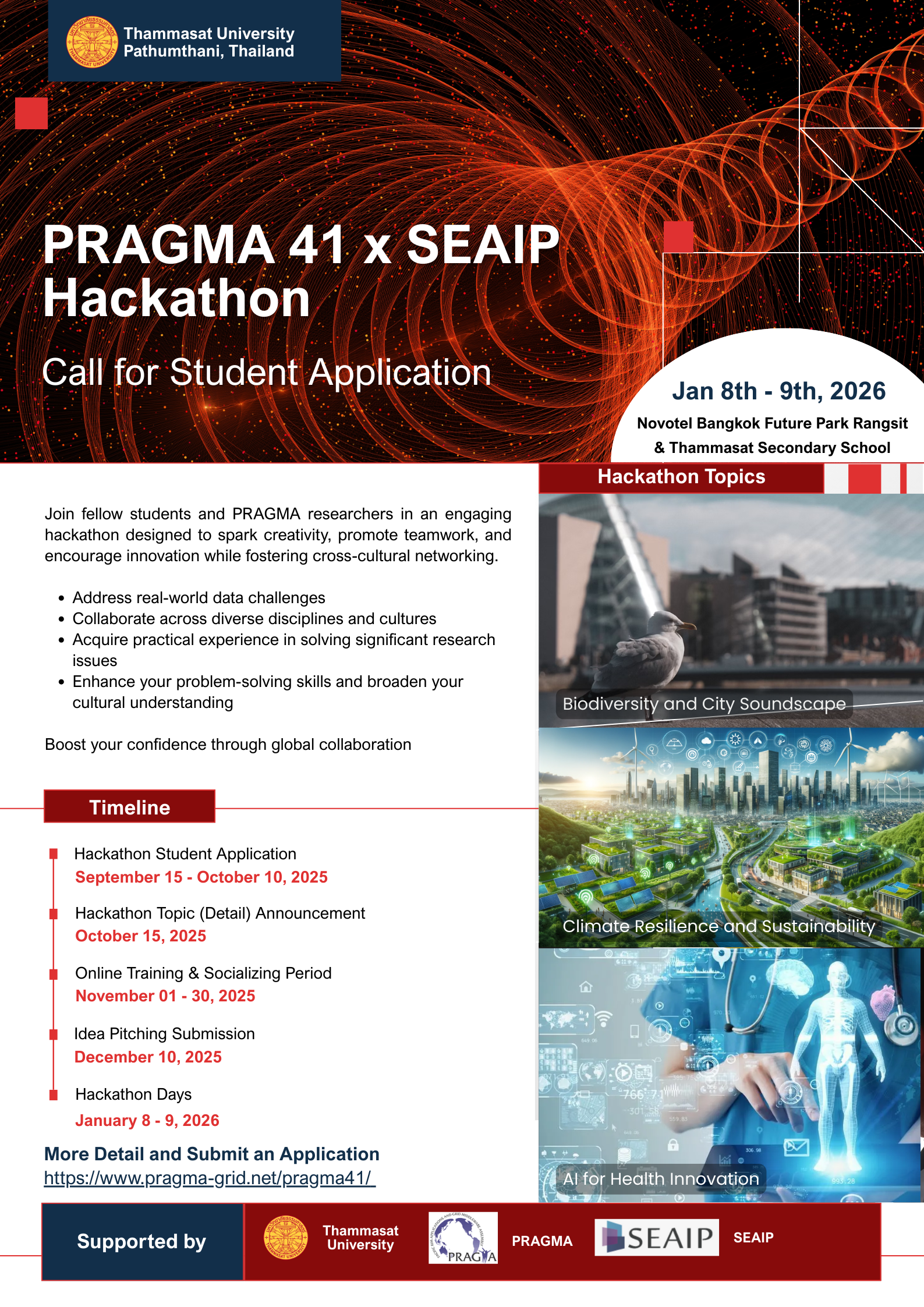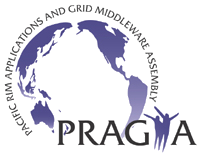Important Dates (Hackathon)
- Oct 202510Hackathon StudentApplication Deadline
- Oct 202515Hackathon Topic (Detail)Announcement
- Nov 20251-30Online Training &Socializing Period
- Dec 202510Idea Pitching Submission
- Jan 20268-9Hackathon days
Call for PRAGMA 41 x SEAIP Student Hackathon
🧩 PRAGMA 41 x SEAIP Collaborative Action Hackathon 🧩
Join fellow students and PRAGMA researchers in an engaging hackathon designed to spark creativity, promote teamwork, and encourage innovation while fostering cross-cultural networking.
- Address real-world data challenges
- Collaborate across diverse disciplines and cultures
- Acquire practical experience in solving significant research issues
- Enhance your problem-solving skills and broaden your cultural understanding
Boost your confidence through global collaboration.
Download the Call Poster

Hackathon Topics
AI for Health Innovation - Developing Sustainable Solutions for Global Challenges
Background
The convergence of artificial intelligence (AI) and healthcare represents a transformative frontier for addressing some of the most critical issues facing our planet. AI technologies such as machine learning, deep learning, computer vision, and natural language processing have demonstrated potential in diagnosing diseases and predicting epidemics. However, their full potential remains untapped due to challenges like data scarcity, ethical concerns, and the need for context-specific solutions.
This hackathon aims to catalyse cross-disciplinary innovation, bringing together technologists and healthcare professionals, to develop actionable AI-driven solutions. By fostering collaboration and creativity, it seeks to accelerate the development of impactful tools that can improve health outcomes, especially in underserved regions.
Example contributions/projects
- AI Tools for Early Disease Detection and Diagnosis: Develop an AI model that analyzes retinal images or chest X-rays to detect diabetic retinopathy or pneumonia at an early stage, enabling prompt treatment and reducing complications.
- Predicting and Managing Disease Outbreaks: Design a system that combines travel data, environmental factors, and reported symptoms to forecast influenza outbreaks in specific regions, supporting health authorities in resource planning.
- Creating Accessible and Scalable Solutions: Design a lightweight AI app that can run on mobile devices to assist community health workers in diagnosing common diseases in rural areas where internet connectivity is limited.
Smart Solutions for Climate Resilience and Sustainability
Background
Climate change is increasing the frequency and intensity of extreme weather events, such as floods, droughts, and heatwaves, posing significant threats to communities, infrastructure, and natural ecosystems worldwide. Addressing these challenges requires a dual approach: building resilience to withstand and recover from climate impacts, and promoting sustainability to mitigate future risks.
This hackathon focuses on leveraging technology and innovative thinking to create practical solutions that protect vulnerable populations and foster a sustainable future.
Example contributions/projects
- Smart Agriculture and Water Management: Develop precision irrigation systems using IoT and predictive analytics to optimize water usage for crops during drought conditions.
- Smart Buildings and Energy Efficiency: Design intelligent building management systems that automatically reduce energy consumption during peak demand (e.g., heatwaves) to prevent grid overload and ensure continuous operation.
- Smart Evacuation and Disaster Response: Use real-time data (e.g., traffic, weather, social media feeds) to create dynamic and adaptive evacuation routes during a disaster to avoid bottlenecks and guide people to safety efficiently.
Biodiversity in the City Soundscape
Background
Urban areas are filled with both human-generated noise and natural sounds from various sources including wildlife, transportation, and reproductive sources, etc. Noise pollution can disrupt animal communication, alter species distribution, impacts on human health, and impact ecosystem health. While various institutions and citizen scientists collect noise and biodiversity data, these datasets often remain isolated, inconsistent in format, and difficult to analyze together. The lack of integrated, cross-location studies limits our ability to understand how urban soundscapes influence biodiversity — and how communities might protect or restore natural acoustic environments.
This hackathon invites participants to explore the intersection of urban noise and wildlife using provided and/or open-source datasets. The goal is to develop innovative tools and insights that help cities monitor, protect, and restore natural acoustic environments—enhancing biodiversity, resilience, and quality of life in urban spaces.
Example contributions/projects
- Integrating Noise and Biodiversity Data Across Urban Sites: Design a system that merges acoustic and biodiversity datasets from multiple institutions and locations, accounting for differences in format and quality. The goal is to enable comparative analysis across cities or regions, helping researchers identify trends in species distribution and noise impact.
- Visualizing Urban Soundscapes for Community Engagement: Create interactive visualizations that map noise levels and biodiversity indicators over time and space. These tools should help researchers and local communities spot patterns, anomalies, or thresholds where noise may begin to affect wildlife behavior.
- Smart Monitoring and Device Health Tracking:: Develop a dashboard or tool that monitors the operational status of acoustic and biodiversity sensors deployed in urban environments. Include metrics such as energy consumption, uptime, and data quality to ensure reliable long-term monitoring and facilitate maintenance across distributed networks.
Note: Student contributions are not limited to the examples provided. Creativity is encouraged, as long as the work remains relevant to these three topics.

